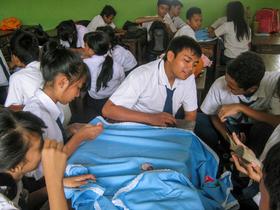For the 2025-26 school year, there are 2 public preschools serving 126 students in the neighborhood of Old Louisville, Louisville, KY.
The neighborhood of Old Louisville, Louisville, KY public preschools have a diversity score of 0.55, which is more than the Kentucky public preschool average of 0.41.
Minority enrollment is 79% of the student body (majority Black), which is more than the Kentucky public preschool average of 24% (majority Hispanic and Black).
Best Public Preschools in the neighborhood of Old Louisville, Louisville, KY (2025-26)
School
(Math and Reading Proficiency)
(Math and Reading Proficiency)
Location
Quick Facts
Rank: n/an/a
900 S Floyd St
Louisville, KY 40203
(502) 485-7008
Louisville, KY 40203
(502) 485-7008
Gr: PK | 174 students Student-teacher ratio: 16:1 Minority enrollment: 90%
Rank: n/an/a
Heuser Hearing & Language Academy
Special Education School
111 E Kentucky St
Louisville, KY 40203
(502) 636-2084
Louisville, KY 40203
(502) 636-2084
Gr: PK-K | 10 students Student-teacher ratio: 10:1 Minority enrollment: 40%
Frequently Asked Questions
How many public preschools are located in the neighborhood of Old Louisville, Louisville, KY?
2 public preschools are located in the neighborhood of Old Louisville, Louisville, KY.
What is the racial composition of students in the neighborhood of Old Louisville, Louisville?
the neighborhood of Old Louisville, Louisville public preschools minority enrollment is 79% of the student body (majority Black), which is more than the Kentucky public preschools average of 24% (majority Hispanic and Black).
Recent Articles

School Vouchers: Updated Pros and Cons (2025 Review)
Comprehensive 2025 analysis of school vouchers, weighing benefits and challenges for families, funding, outcomes, and policy directions.

Benefits and Drawbacks of Homework in 2025
Explore updated 2025 insights on homework鈥檚 benefits, drawbacks, mental health impact, best practices, and policy trends in U.S. public schools.

Charter Schools vs Public Schools 2025: Key Differences & Trends
Explore updated 2025 insights comparing charter schools vs public schools, enrollment, academic outcomes, funding, and real-world examples for families and educators.
